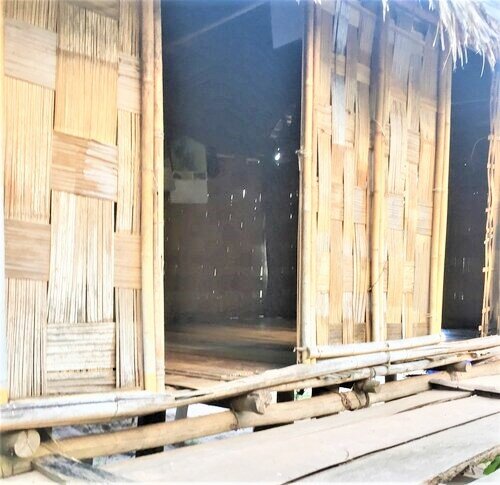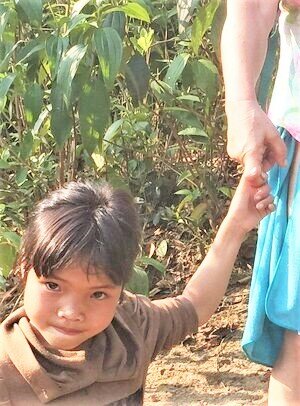vaga#4/7 Arem and Chut Tribus
Part VII
Bouarapha district, the northwestern centre of Vietnam on the border with Laos, they do not follow borders, I make the point, that the borders that we know today were defined by the French and English colonies, so the ethnic groups were between two or more countries. They are located in an extremely remote place, I had the great luck to go with a Canadian who wanted to make a plan to tour of the ethnic area, I was the third of his tours which was the prototype, of the tour), I think that shortly after no more tours were done because there was no interest. There are two groups, the Arem and Chut are among others. The Vietnamese Arem are part of the Chut ethnic group, there are between 4 and 7 different tribes in the region that are quite limited in number and put them in the same bag as the Chut. They are known as the most primitive in the country.
THE CHUT
the meaning of Chut is "rocky gorge" because many come from there and still live on the rocks. There are several groups that live in different hamlets, of about 18 huts, they pass as a family clan and each one of them has agreements on trees, rivers, estuaries, and they respect it so as not to provoke a war between them. Many clans meet once a year and for three days to play the drums, there are hundreds of drums played without stopping. I visited two Chut hamlets an hour away from each other, you can get there on foot only. They have rarely seen tourists, the guide said that no more than 15 tourists had been there, those who had arrived, and he had to do many government procedures to let them enter the area, on the way there is a military control post, that checks, he says it is also because they are on the border. The natives show distance, but not upset. In this village I saw women grinding rice, that is, separating the husk from the grain, as they have been doing for 20 centuries. There were a few cows, wandering around which are donated by the government, the electricity came to the hamlet a couple of months before I arrived, and it reached a generator in the hamlet, they charge torches and some electric tool to cut down trees (I think) and the houses are without power. There is a school that serves several hamlets, the children go to school for 20 days in a row from first to fourth grade, that is, reading, writing, learning Vietnamese and basic maths. The teacher by requirement has to learn her dialect before teaching. She returns to civilisation for 10 days, the salary is three times higher than a teacher in the city.
They sit around all day, I did not see any action, the last photo of the man looking out the window, I had previously described the ethnic groups of the north where the hands do not stop with embroidery, handicraft sales, crops, etc…. rice is ground here for the day, no handicrafts are made, if a basket is needed it is woven and used. An isolated house with solar energy, weird, I knew that there are foreign foundations that support something.
the interior of the houses have only mats on the floor and rope for hanging clothes, outside two pots for cooking and the fire, they eat by hand out of the pot, there is a bucket for water and that's all. The huts are made by themselves (the Arem are not), they are made of coarse woven bamboo, on stilts, when they make new ones they use thick wooden planks, and recently they have incorporated the zinc roof.
This is the other town, rice is milled for family consumption and river fishing. There is no trade, there is no money, the exchange works, they exchange with Laos (there are weavers) for skirts in this case green, they change colour between towns, so they can identify each other. What impressed me again was no crafts, again nobody does anything, there were a couple of pigs.
I saw Mongoloid features, and she had a toy cell phone
the guide said we are going to the river to make a stop, we started to go down, and I was surprised by a little girl of about 4 years old who took my hand, one finger and took me to the river for about 10 minutes walking ……. PLOP !!!!!
Suddenly about 6 little boys came to bathe naked spontaneously it came to my head, they are like "wild creatures", they bathed, played with sticks and climbed the rocks as if nothing had happened, with surprising ability and speed, they come from living in rocks.
in the river, a young boy cooked the fish of the day to feed the community.
Obviously, I also enjoyed the river with my maximum madness of jumping over 30 meters high. LOL
They stock up every so often, a motorcycle arrives from a village 20 minutes away, and they exchange merchandise, surely for fish.
THE AREM
The Arem people are absolutely different, they have their own dialect, they are all branches of the Mon-Khmer language. The language is only oral. The meaning of Arem, those who live in caves in the gorges, today there are less than 80 people with pure Arem blood, they have been mixed with the Chut as well as the dialect. Vietnam recently recognised them a couple of decades ago, they were the last ethnic group and because they were so primitive they did nothing for a long time. When the country got involved, it gave them huts, created a hamlet of 4 blocks, 6 houses for blocks, all identical. The first years, no one went down to the houses, they preferred to live in their caves and in the trees, they were nomads, then they began to go down for a few months and returned to the caves. They have no religion, no rituals. To implement the town that will be about 10 years old, the road was built, you get there by car. To tempt them to go down to the hamlet of 24 houses they gave them food, clothes, cows. They introduced money, they set up a small kiosk that sells oil, cigarettes, rice, and other things. They do not know how to use money, they taught them to sell the honey they get from the trees because they are self-sufficient in hunting and gathering forest vegetables. They hunted endangered animals, I think a turtle and/or a monkey, they sold them to an intermediary for US $8, and it ended up being sold in China for US $40,000, the community lived for two years with what they received, the government has prohibited it because they are an endangered species. The government taught them about agriculture, but I did not see orchards, or rice milling, I don’t think it happens there. Here and again no one doing anything, all sitting outside their houses in groups. There is a primary health post, it spent more than 5 years there without anyone stepping in it. They did not believe in medicine, they continued with their shamans, there is also a very large cement school (disproportionate to the size of the hamlet) I had to see it in action, the same as 20/10 days. The first thing in the morning they are taught personal hygiene, they give them toothbrushes, toothpaste and soap, they eat lunch and once a week they show them a film. An incomprehensible thing is that there is no source of natural water, only rain. How do they design a town without access to natural water? A German foundation dug a well, and they pump water out using solar energy. Another thing that surprised me is that each house had the Vietnamese flag, they are not from any country, they are from that geographical part, period, so the government, by giving them all that "assistance" wanted them to identify themselves as Vietnamese. I was wondering to myself when seeing this artificial implant and trying to change their ethnicity, I have my doubts, to impose civilisation on them. They no longer worry about food, water, hut, clothes ... they are given everything (hmm?) The other point is they skipped a tremendous period of civilisation to go down from their caves to school with television, money, satellite signal ...... Mari, my friend wrote to me asking if they were happy. I told her that the concept of happiness is modern and/or a sophisticated state. There they live, eat, sleep, reproduce, defecate and nothing else without expectations ..... what could it be? They have nothing, the only thing I learned of expectation was the couple's meeting to start a family, the boy gives his in-laws his basic knife as a dowry. Currently, they are totally dependent, they are no longer nomads, they have given in and now live regularly all year in the village. I think their dignity has already been lost. So many things that cross my mind ... Is it correct? Well the Arem case is extreme.
photos of the school and with my technique of taking photos and showing them poof they were all in an uproar
This man approached us and began a monologue of about five minutes as if reciting a story, he was not scared of us, he was with 2 young Germans and the guide, he had seen the guide I was with several times, he says that is why he approached us
I end with this video for having had the incredible opportunity to witness it






















































